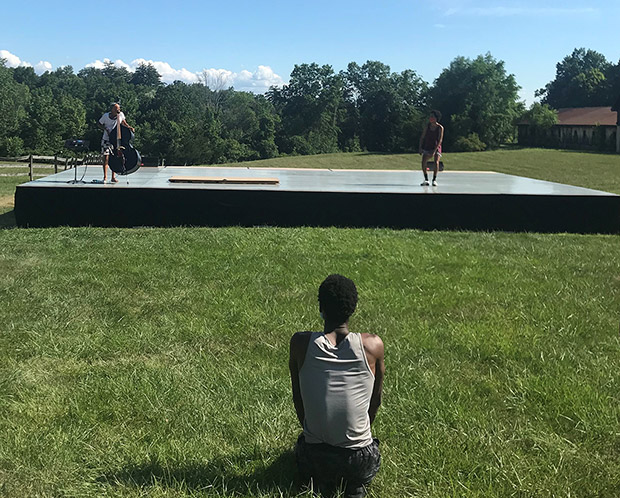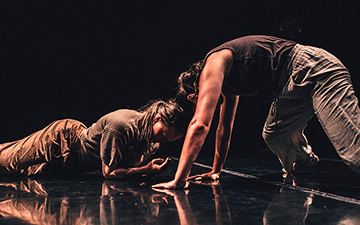
© Quinn Wharton. (Click image for larger version)
Kaatsbaan Summer Festival 2020
Larry Keigwin’s Sunshine, Leonardo Sandoval’s Laying the Ground, Calvin Royal III’s The Dividing Line and The Dream Continues
★★★★✰
New York, Tivoli, Kaatsbaan Cultural Park
1 August 2020
kaatsbaan.org
The Real Thing
Imagine tasting a fresh peach after living on the canned variety for months, or seeing a human face after months of talking on the phone. It’s hard to put into words what it felt like to experience a live performance for the first time since March, but this I know: it felt good. My body relaxed, my senses opened. I experienced time in a different way. For the 25-minutes or so of the performance, I thought of nothing else but the people moving before me, the way their movements fit into the music, the feeling of the air all around us, the way the sky and the green of the trees outlined and complemented the shapes and figures on the stage. A window opened, and then it closed again.
The idea behind the Kaatsbaan Summer Festival is simple: build an outdoor stage on a beautiful property in the Hudson Valley of New York state that is already devoted to dance; invite dancers; quarantine them for a few days; welcome a small audience to enjoy a brief performance consisting of mainly solos and duets. The audiences are limited to 50 by current Covid restrictions, and performances are less than ½ hour long to prevent prolonged exposure. Seldom has something so simple seemed so meaningful and, really, so necessary. We’ve all been sitting at our computers for months, consuming art the same way we do our work, on a flat rectangular screen. We’ve done our best to imagine how this thing we are watching in flattened form might feel in a real 3D world in which we share the same air and hear the same sounds as the performers. And along the way, art too has begun to feel like work.
In contrast, watching dance at Kaatsbaan, a former farm located in Tivoli, was nothing at all like work. As the first piece, Sunshine, choreographed by Larry Keigwin and performed by the American Ballet Theater dancer Melvin Lawovi, began, a quiet settled over my mind. I believe the same happened to every person present. All that mattered was this one dancer, responding to Bill Withers’s song Ain’t No Sunshine, moving with breezy nonchalance, holding a balance in an attitude, turning again and again as Withers’s voice repeated “I know, I know, I know, I know.”
Lawovi’s quiet, floating performance was followed by a tap solo (Laying the Ground) by Leonardo Sandoval, accompanied on the double bass by Gregory Richardson. The two took the stage wearing masks. After a few seconds, Sandoval removed his. Free at last! His solo began softly, mostly with body percussion, in conversation with Richardson’s fingers rapping against the side of the bass. Then the tapping began, soft rivulets of sound, the movements and rhythms becoming bigger and more complex as the dance progressed, but never erupting into a showy avalanche of steps. Their performance was low key, intimate, sweet.
The final two pieces, also solos, were by Calvin Royal III, curator of the evening. The festival, which was conceived in the wake of the renewed Black Lives Matter movement, is co-curated by Stella Abrera, the festival’s artistic director, and Sonja Kostich, its artistic director, along with an advisory committee made up of three black dancers: Calvin Royal III, Lloyd Knight, Alicia Graf Mack. Each has contributed in different ways. Royal’s first piece was a solo for himself, set to the second of Gershwin’s “Three Preludes,” a slow, slurring melody that suggests heat, melancholy thoughts, blurred memories. The dance felt sorrowful, marked by a motif of bound hands. (Oh but that arabesque!) In the middle section, where the music speeds up, Royal broke free for a moment, only to leap into a fall and then return to his sorrowful dirge.
The second solo was for Courtney Lavine, a fellow ABT dancer, all-too-seldom showcased. She is a dancer of great sweetness and grace, and a kind of gravity – there is something almost old-fashioned about her. Her solo was set to an excerpt from Martin Luther King’s “I Have a Dream” speech: “I have a dream that every valley shall be exalted, every mountain and hill shall be made low,” words from the Book of Isaiah rendered familiar by Handel’s Messiah. It might seem like a cliché to use Martin Luther King’s speech as the backdrop for a dance, but King’s voice is so melodious, so ringing and full of emotion (it reminded me of Caruso’s voice), and so full of hope, that it felt right just to sit and listen. The choreography didn’t try to compete with the words – how could it? – but Lavine was not overshadowed. Through the grace and purity of her dancing, she seemed to embody the hopefulness and seriousness of King’s message.

© Quinn Wharton. (Click image for larger version)
Like the lighting installation “In Light: Of the Time,” created by a team of poets, artists, and lighting designers, that one walks through as one enters the grounds, the entire festival is dedicated to the ideals of equality, social justice, mutual respect. Sadly, as is often the case at dance performances, the audience was less diverse than the team of creators and artists. The dance world, like the rest of our world, is still a divided place.
Halfway through the performance, Royal’s recorded voice was heard reciting the Langston Hughes poem “Harlem”: “What happens to a dream deferred? Does it dry up / like a raisin in the sun? / Or fester like a sore?” In 2020, too many dreams have been deferred to count. Kaatsbaan isn’t a solution or a cure. It won’t change the world. It can’t even bring live dance back as it was before the month of March. But for half an hour, it offers the respite of communication without words, of the beauty of the body moving freely through space, and of shared experience.

















Glorious thoughts, written as only Marina can, yet simple, basic -it must have been a wonder, equally well recorded.
also noted; photographer Qwinn Horton , one time SFB corps member, then Hubbard Street in Chicago..
Did the photography for the Helimets ensemble to his native Estonia. Nice images –
congratulations.